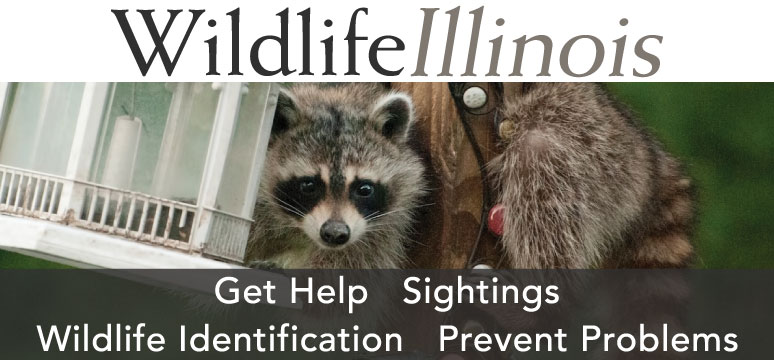
Photo courtesy of the Illinois Department of Natural Resources.




Photo courtesy of the Illinois Department of Natural Resources.
It can’t be denied that white-tailed deer are doing well in Illinois. Extremely well. They are a common sight in backyards, corn fields, and forests, but it wasn’t always this way. Overhunting almost wiped-out white-tailed deer at the start of the 20th century. Regulating hunting and conservation efforts saved the species and allowed them to rapidly recover. Now, white-tailed deer roam everywhere, from Shawnee National Forest in southern Illinois to the suburbs of Chicago in the north. This is a story of famine to feast, which raises a question: How are Illinois deer so successful?

With wolves and other apex predators, such as black bears and mountain lions, becoming extirpated in Illinois and the arrival of European settlers in the 19th century, humans now provide the primary source of predation and population control. Without natural predators, deer can become very abundant. Modern wildlife management strategies and regulated hunting help ensure white-tailed deer populations are kept at sustainable levels while balancing public interest (e.g., hunting success, agriculture, habitat damage, wildlife enjoyment, public safety, disease and more).
Interestingly, record confirmation of species that existed in Illinois before 1900, such as mountain lion, gray wolf and black bear, became more prevalent since the early 2000s. Still, by 2022, researchers investigating these animals have indicated no strong evidence of breeding populations despite several confirmed sightings of these species passing through Illinois during the past decade (Nielsen 2022). However, deer populations could be affected by other predator species, such as bobcats and coyotes, smaller predators that, due to the disappearance of apex predators, now dominate the Midwest (Gorman et al., 2022).
Being a common prey species that evolved along with many large predators trying to eat them since the Pleistocene Epoch at least 2 million years ago, white-tailed deer had to reproduce quickly and often (Thomas 2022). Female white-tailed deer produce an average of two fawns per year, though this number can be as high as five, and some even reproduce while being fawns themselves (Green et al., 2017). This means that some deer can become many deer in a relatively short amount of time.
Another key factor is the available deer habitat, where deer eat, sleep, hide, mate and have babies. The thought of deer habitat likely brings to mind a forest preserve or the woods on your property, but forests are not the only type of land cover – the classification of land as forest, crops, wetlands, and such – that white-tailed deer use. In fact, white-tailed deer are known as an “edge species,” meaning that they prefer to live where two or more types of land meet. For example, a particular favorite of deer is a patch of forest that borders a field of corn. Deer will use the forest for all their functions but appreciate the extra nutrition provided by the crops. This gives another clue as to why deer are so successful in Illinois: humans have chopped up the land into a mosaic of forest and agriculture, with other natural areas – such as wetlands – scattered throughout. Mosaics have lots of edges. Deer love edges.
This makes sense, as most of us have seen deer feasting in the fields after harvest or hanging out in the woods. However, a challenge for researchers is how to translate these observations into numbers that can be used to learn more about deer.

A first idea may be that deer habitat equals the amount of forest in an area, but deer will use other types of land. This complicates things, especially when you start thinking about the quality of the habitat as well as the quantity. As the nuance of the question increases, the answer becomes a “model,” which uses math to approximate real-world phenomena. The phenomenon of how deer use the landscape can be modeled with data such as satellite imagery that divides Illinois into small squares and categorizes them as being forest, agriculture and so on.
Our study titled An Updated Framework for Modeling White‐Tailed Deer (Odocoileus virginianus) Habitat Quality in Illinois (Mori et al., 2024) took that data and sorted those squares into “deer habitat” (forest, wetlands, crops, grasslands and pasture) and “not deer habitat.” Deer habitat was then subdivided into habitats that provided food (crops, grassland and pasture) and habitats that provided both food and shelter (forest and wetlands) since deer don’t interact the same with these groups. The quality of each square was judged by the distance between that square of food/shelter and the nearest patch of food, or vice versa. Quality improved as the distance shortened, with squares closer to the edge between the food and food/shelter areas considered more valuable to deer. Habitat quality scores ranged from 0.2 (lowest quality) to 1.0 (highest quality). Once these were assigned to all deer habitat squares, these scores were added together to get the “deer land cover utility (LCU) score” for the areas of interest (i.e., counties). Figure 1 shows the deer LCU scores, with darker areas corresponding to more, better deer habitat.

One look at this map will tell you that Illinois has a lot of deer habitat, and good deer habitat, too. Even the seas of corn in east central Illinois are interrupted with enough deer habitat to sustain sizeable populations. The map also shows the outlines of many rivers, with habitat following these water ways along with the deer. The land and the resources were, and are, there, so once the heavy burden of free-for-all hunting was lifted, deer were easily able to recolonize. Combined with the continued absence of non-human predators and their impressive capacity for producing offspring, these deer have found the Illinois landscape one of safety and bounty. And they have taken full advantage.
The deer LCU score fits into this story by condensing information about the quality and quantity of deer habitat within given geographical areas of Illinois. Such a variable will make future research and modeling of white-tailed deer easier by providing a validated metric of deer habitat. This deer LCU score is also available for smaller geographical scales, opening new opportunities for inclusion in more local models. So, this work has aspects that may be casually interesting and aspects that could be important for research, but overall, it’s clear that Illinois is just a great place to live, no matter how many legs you have.
Dr. Jameson Mori is a postdoctoral researcher with the Mateus & Novakofski Chronic Wasting Disease Collaborative Labs. Their research focuses on using data and modeling to determine the impact of chronic wasting disease on white-tailed deer in Illinois and the effectiveness of management efforts to control the disease. They earned their B.S. at the University of Massachusetts Dartmouth and Ph.D. from the University of Illinois Urbana-Champaign.
Dr. Nelda Rivera's research focuses on the ecology and evolution of new and re-emerging infectious diseases and the epidemiology of infectious diseases, disease surveillance, and reservoir hosts’ determination. She is a member of the Wildlife Veterinary Epidemiology Laboratory and the Novakofski & Mateus Chronic Wasting Disease Collaborative Labs. She earned her M.S. at the University of Illinois at Urbana-Champaign and D.V.M at the University of Panamá, Republic of Panamá.
Submit a question for the author
Question: When it’s the best time for hunting whitetail deer